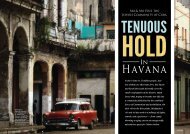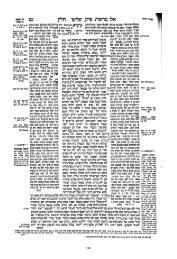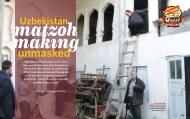The Jews of Namibia - Halachic Adventures
The Jews of Namibia - Halachic Adventures
The Jews of Namibia - Halachic Adventures
Create successful ePaper yourself
Turn your PDF publications into a flip-book with our unique Google optimized e-Paper software.
orns<br />
AND<br />
horns<br />
theafrican<br />
in<br />
ush<br />
We were bumping our way in a Jeep over the wild<br />
African terrain, while a daredevil helicopter following<br />
us overhead, herding the game into a quarter-mile long<br />
blind. We’d never shechted antelope before, and this<br />
would certainly be an authentic way to feel what it’s like<br />
to be Jewish in <strong>Namibia</strong><br />
text and photos by Ari Z. Zivot<strong>of</strong>sky and Ari Greenspan<br />
ARI AND ARI PRESENT<br />
Quest<br />
mesor ah<br />
46 MISHPACHA
W<br />
We were i n South Africa for what were<br />
supposed to be a few relatively quiet days<br />
— giving a few lectures, visiting some old<br />
synagogues, and shechting cows and sheep. But as we’ve already learned time and<br />
again, on our halachic adventures, things can turn interesting in unexpected ways.<br />
Several hours before Shabbos we heard the phone chirp, indicating an SMS: “Would<br />
you like to shecht buck in <strong>Namibia</strong>” Well, an opportunity like that is irresistible to a<br />
pair <strong>of</strong> halachic adventurers like ourselves, and so Erev Shabbos we were busy booking<br />
flights to South Africa’s neighboring country.<br />
We got the last two seats on a Sunday morning flight to Windhoek,<br />
the capital <strong>of</strong> <strong>Namibia</strong>. Formerly known as South West Africa,<br />
<strong>Namibia</strong> gained independence from South Africa in 1990,<br />
and is blessed with extensive game and African wildlife. We were<br />
being sent by Rabbi Desmond Maizels, a kindred spirit and friend<br />
as well as a rabbi in Cape Town who periodically shechts for the<br />
few <strong>Jews</strong> in <strong>Namibia</strong>. He told us that we would have an adventure<br />
as well as enjoy the hospitality <strong>of</strong> the central Jew in town,<br />
Zvi Gorelick, and he was correct on both counts.<br />
<strong>Jews</strong> in <strong>Namibia</strong> Zvi Gorelick, our warm and welcoming<br />
host, is the man who single-handedly keeps this<br />
community going. He told us how the first <strong>Jews</strong> came to<br />
<strong>Namibia</strong> in the 1880s looking for business opportunities in<br />
guano, a widely used fertilizer from the feces <strong>of</strong> sea birds,<br />
bats, and seals, found in great unadulterated quantities<br />
<strong>of</strong>f ocean coasts. <strong>The</strong>se Jewish entrepreneurs were given a<br />
communal boost when the region came under German rule<br />
in 1884: Jewish soldiers numbered among the occupying<br />
German army.<br />
In a 1915 side battle <strong>of</strong> World War I, South Africa defeated the<br />
Germans and occupied what they called South West Africa, yet<br />
even today, close to a hundred years later, there is a distinct German<br />
character to the town <strong>of</strong> Windhoek. Many <strong>of</strong> the stores and<br />
restaurants have German names and even write their menus in<br />
that language. Many <strong>of</strong> the whites we saw spoke German, and<br />
“Would you like<br />
to shecht buck in<br />
<strong>Namibia</strong>” Well,<br />
an opportunity<br />
like that is<br />
irresistible to a<br />
pair <strong>of</strong> halachic<br />
adventurers like<br />
ourselves<br />
there are direct flights to Germany a few times a week.<br />
Southern Africa was actually a distant, safe haven<br />
with fresh opportunities for persecuted Eastern European<br />
<strong>Jews</strong> in the early 1900s. Zvi’s father, Samuel,<br />
was 16 years old when he arrived in South Africa in<br />
1925 from a village near Minsk in the Pale <strong>of</strong> Settlement.<br />
He was a saddle stitcher, but the age <strong>of</strong> horses<br />
was pretty much over, and he soon found employment<br />
fixing car seats. But then the Depression hit<br />
and many local <strong>Jews</strong> found themselves out <strong>of</strong> work,<br />
spending their days in Cape Town drinking tea and<br />
eyeing the future. Presently two Persians by the name<br />
<strong>of</strong> Azizoloh<strong>of</strong>f (whose South African descendants we<br />
serendipitously know) showed up<br />
transporting Persian lamb, Karakul,<br />
which they planned to raise<br />
in the country. <strong>The</strong>y were looking<br />
for opportunities in South West<br />
Africa and Samuel decided to<br />
join them.<br />
Refuge in the Bush<br />
<strong>Namibia</strong> is one <strong>of</strong> the least<br />
populated (2.1 million) and<br />
least densely populated (6.6<br />
per square mile) countries in<br />
the world, and the capital and<br />
largest city Windhoek has<br />
only 240,000 people. But the<br />
country is blessed with fauna,<br />
KOSHER FOREVER Windhoek’s cemetery is the most<br />
accurate witness to the city’s Jewish citizens; (right) Walter<br />
Galler’s wife paid tribute to her Jewish husband by cutting<br />
the Hebrew words <strong>of</strong>f a matzoh box, even though they<br />
wound up upside down on the tombstone<br />
Zvi Gorelick is <strong>Namibia</strong>’s gabbai,<br />
melamed, kashrus supervisor,<br />
and chevra kadisha<br />
48 MISHPACHA 17 Av 5773 | July 24, 2013 MISHPACHA 49
including much big game, which contributes to its<br />
tourism industry. At the time, though, Sam Gorelick<br />
and his new friends weren’t interested in the<br />
herds <strong>of</strong> zebra or giraffe; they were just fortunate<br />
they could build a community free <strong>of</strong> persecution.<br />
Together with other pioneers, Sam built a kehillah<br />
that reached its heyday in the early 1960s with<br />
about 150 families. It included a Talmud Torah<br />
with around 150 kids, a rabbi/shochet/mohel, and<br />
a community hall. <strong>The</strong> area was under South African<br />
rule at the time, and many Jewish South African<br />
soldiers were stationed there — <strong>of</strong>ten more<br />
than a hundred <strong>of</strong> them came for davening on Yom<br />
Tov. <strong>The</strong> community slowly dwindled, and today<br />
only a few dozen remain, mostly transient Israeli<br />
businessmen.<br />
Meeting Zvi, an authentic shomer mitzvos who opened<br />
his home and his heart to us, was a pleasant surprise. As<br />
kosher meat is not available unless somebody shechts<br />
locally or gets a special delivery, we brought him packaged<br />
meat from Johannesburg to supplement the<br />
shipment <strong>of</strong> chickens he received from Cape Town<br />
for Pesach. And our second surprise was the bounty<br />
<strong>of</strong> Johannesburg Beis Din–endorsed products found<br />
in the local supermarket. We joked with him that we<br />
had not seen so many kosher products since our trip<br />
to the supermarket in Bahrain (reported in Mishpacha<br />
issue #279), where the mass <strong>of</strong> imported products included<br />
a plethora <strong>of</strong> kosher items from the US and UK.<br />
Zvi holds the tiny community together — he runs the<br />
prayer services, arranges for Kaddish, teaches Torah<br />
to whomever is interested, and gives occasional bar<br />
mitzvah or bas mitzvah lessons.<br />
<strong>The</strong> Gorelicks were pillars <strong>of</strong> the community, and<br />
Zvi learned early on about responsibility — when he<br />
was little he’d <strong>of</strong>ten stay late Shabbos morning and<br />
help clean up the shul. In Talmud Torah, they would<br />
say the Shema out loud together, but one day when the<br />
teacher asked each one to recite it individually, it was<br />
obvious that the kids were just mumbling along and no<br />
one knew more than the first two lines. Zvi felt bad and<br />
came back to the teacher two days later, having proudly<br />
memorized the entire text. As a reward he was given<br />
the privilege <strong>of</strong> closing the shul windows after davening<br />
on Shabbos morning, a job he still performs with<br />
devotion all these decades later.<br />
<strong>The</strong> community never did build a mikveh, but members<br />
would go to a nearby dam on a river. At one point<br />
Sam’s brother Sholom tried to rig up a floating dock with<br />
WHERE THE ANTELOPE PLAY At the game farm, animals<br />
are herded into a long, funnel-shaped blind that closes in on<br />
them from behind, until they’re contained in a small metal pen,<br />
ready for slaughter. (Inset) Ari G. is ready with his chalaf, while<br />
(right) Ari Z. bids farewell to the second gemsbok<br />
curtains around it for privacy, but it capsized<br />
on the first person to use it. It’s been years<br />
since <strong>Namibia</strong> had a resident rabbi, the last<br />
one being Rabbi Isaac Menashi, who left in<br />
1994. Some <strong>of</strong> the previous rabbis and religious<br />
leaders were Rabbi Zalman Rachman,<br />
Rabbi Chaim Perez, and Rabbi Phillip Krein.<br />
Mrs. Elana Rachamim taught Talmud Torah<br />
here for 17 years.<br />
We asked Zvi if there ever was a second shul<br />
in Windhoek; he smiled and said that “with<br />
150 families one shul was good enough. Now<br />
that we have 10 families, we need a second<br />
shul.” <strong>The</strong>re had been two more shuls in the<br />
country years back, one in Swakopmund that<br />
burned down in 1916, and the other in Keetmanshoop,<br />
which closed in 1956 and is now<br />
a dairy. <strong>The</strong>re are still Jewish cemeteries in Swakopmund,<br />
Keetmanshoop, and Lüderitz.<br />
<strong>The</strong> Windhoek shul, which still has a charity fund that supports<br />
four widows, was originally constructed in 1924 and<br />
modeled on the style <strong>of</strong> German synagogues, with the bimah<br />
next to the aron kodesh on a raised platform, and women seated<br />
upstairs. <strong>The</strong> building, originally erected in a quiet, open area,<br />
is now surrounded by commercial buildings, including an elevated<br />
pedestrian mall. As we entered the locked gate <strong>of</strong> the shul<br />
— which was repainted in 2009 — Zvi noticed that the security<br />
wall, topped with an<br />
electric fence to keep out<br />
“with 150<br />
families one<br />
shul was good<br />
enough. Now<br />
that we have 10<br />
families,<br />
we need a<br />
second shul”<br />
prowlers (such fences are<br />
ubiquitous in South African<br />
Jewish communities),<br />
had been tampered<br />
with. <strong>The</strong>n he pointed<br />
out the heavy metal<br />
screens on all the windows<br />
and explained that<br />
they were put in place after<br />
rumors surfaced <strong>of</strong> a<br />
planned grenade attack<br />
on the shul in about 1978;<br />
the screens would deflect<br />
the grenades.<br />
Over the years, Zvi has<br />
planted many trees on<br />
the property, yet we noticed<br />
that there was no esrog tree. We suggested that he plant<br />
one, but he adamantly refused, answering, “my father said definitively<br />
that esrogim must come from Eretz Yisrael.”<br />
With such a dwindling community, we naturally asked Zvi<br />
about the chevra kadisha, and not surprisingly, he is the chevra<br />
kadisha — although he wistfully admitted that he worries, “Who<br />
will do my taharah and levayah”<br />
Finally Kosher As we walked through the well-kept<br />
Jewish cemetery, we couldn’t help noticing many graves<br />
<strong>of</strong> young children and babies. In the early years <strong>of</strong> the<br />
community, life must have been difficult and health care<br />
minimal. We passed the tombstone <strong>of</strong> a young man named<br />
50 MISHPACHA 17 Av 5773 | July 24, 2013 MISHPACHA 51
Seeing the bush from the sky in an open cockpit<br />
with wildebeest and giraffe stampeding below<br />
rounded out our African adventure<br />
Moshe Charney, and could only guess as<br />
to the adventures <strong>of</strong> his life and the tragedy<br />
<strong>of</strong> his death at age 18 by reading his<br />
epitaph (loosely translated from the Hebrew):<br />
“You yearned to go up to Israel and<br />
help others to as well/ But Death met you<br />
and inserted itself in your way/ And like<br />
Moses you too died in this desert.”<br />
Over the years some <strong>of</strong> the <strong>Jews</strong> left the fold,<br />
moved out <strong>of</strong> the small towns, and married<br />
non-<strong>Jews</strong>. One such man was Walter Galler,<br />
who lived in Swakopmund, then a small German<br />
port on the Atlantic, up the coast from<br />
the larger and better situated British port <strong>of</strong><br />
Walvis Bay. Yet it seems that no matter how<br />
far a Jew may stray, when Pesach arrives he<br />
strives to procure some matzoh, and indeed<br />
that is what Mr. Galler did every year. When<br />
Mr. Galler passed away in 1939 at the age <strong>of</strong><br />
51, his widow wanted to have some mention<br />
on his tombstone <strong>of</strong> his Jewish heritage in<br />
addition to the Magen David. So she cut out<br />
the Hebrew “kosher l’Pesach” label from some<br />
matzoh, and the non-Jewish stone mason<br />
then chiseled the letters into the tombstone.<br />
However, not knowing Hebrew, he inscribed<br />
them upside down.<br />
As we were walking, Zvi stopped in front <strong>of</strong><br />
two graves — those <strong>of</strong> his parents. He looked<br />
at us wistfully and announced, “Today is my<br />
father’s yahrtzeit.” He told us about his parents’<br />
devotion to the community and how his father<br />
had been a learned man, having studied with<br />
great rabbis in Belarus. Zvi was able to put together<br />
a minyan for Kaddish the day before, on<br />
Shabbos, but knew there was no way he could<br />
gather one for today. Yet he was pleased that<br />
at least we had accompanied him and recited<br />
Keil Malei Rachamim in their memory.<br />
Lavish Hostage <strong>The</strong>re are other<br />
Jewish connections to <strong>Namibia</strong> as well.<br />
When I sent a message to a friend in Israel<br />
that we were in <strong>Namibia</strong>, he fired back<br />
an SMS within seconds asking if we had<br />
met Kobi (Jacob) Alexander. Kobi is an<br />
Israeli-American businessman who in<br />
1981 c<strong>of</strong>ounded Comverse Technologies.<br />
As Comverse’s CEO, he built it into a global<br />
player that was listed on the NASDAQ 100<br />
and S&P 500. <strong>The</strong> company became a<br />
leader in providing s<strong>of</strong>tware and systems<br />
for telecommunication companies<br />
worldwide.<br />
In 2006 he was charged with multiple counts<br />
<strong>of</strong> conspiracy to commit fraud, relating to the<br />
timing <strong>of</strong> Comverse’s stock option grants. He<br />
fled to <strong>Namibia</strong>, a country with no extradition<br />
treaty to Israel or the US, and today spends his<br />
time with his lawyers trying to arrange his<br />
way out <strong>of</strong> this large jail in which he lives life<br />
lavishly. He has also invested heavily in his adopted<br />
country and recently began to develop a<br />
project on the <strong>Namibia</strong>n coast called Shalom<br />
Park. Zvi recently taught Kobi’s son for his bar<br />
mitzvah, and Kobi flew over 150 friends and<br />
relatives for the celebration. We didn’t have<br />
time to meet the family, but we did speak to<br />
Kobi’s wife, who was busy koshering her kitchen<br />
for her Orthodox family’s imminent visit.<br />
And, so as not to leave out Zvi’s political connections:<br />
former <strong>Namibia</strong>n cabinet minister<br />
Andimba Toivo ya Toivo, once a political prisoner<br />
in South Africa’s notorious Robben Island<br />
jail, married Vikki, a Jewish lawyer. <strong>The</strong>ir twin<br />
girls studied with Zvi for their bas mitzvah.<br />
And then there’s Lev Leviev, who does not<br />
live in <strong>Namibia</strong> but plays a large role here. He<br />
is an Uzbek-born Chabad chassid and noted<br />
billionaire, and is president <strong>of</strong> LLD Diamonds,<br />
which employs over 1,000 <strong>Namibia</strong>ns.<br />
In 2008, a local white woman and Judeophile<br />
named Maggie Edmunds had been sitting at<br />
home in a room with a Magen David and a<br />
Tanach, when a single-engine Cessna carrying<br />
five Israelis from De Beers NamGem diamond<br />
polishing factory crashed through the perimeter<br />
wall <strong>of</strong> her property, bursting into flames.<br />
She and her family were saved, as was the Magen<br />
David and Tanach, but the pilot and five<br />
passengers were killed. Maggie was overcome<br />
with gratitude when she realized that both<br />
she and the Jewish items weren’t damaged,<br />
and felt her personal miracle deserved a memorial<br />
outside her house. A small apartment<br />
was constructed for the families and friends<br />
<strong>of</strong> the deceased when they come to visit, and<br />
she is a regular attendee at the shul.<br />
<strong>Jews</strong> have contributed in many ways to <strong>Namibia</strong><br />
and we were disappointed to discover<br />
that we had just missed one <strong>of</strong> the country’s<br />
Jewish icons. When we came into the shul<br />
we saw a prominent seat marked with a sign<br />
instructing congregants to leave that place<br />
untouched until a certain date. When we<br />
queried Zvi, he told us that it had been the<br />
regular seat <strong>of</strong> Harold Pupkewitz, known<br />
as the “King <strong>of</strong> <strong>Namibia</strong>.” Although we had<br />
not heard <strong>of</strong> him, every <strong>Namibia</strong>n, Jewish or<br />
not, knew who he was. He passed away less<br />
than a year ago at the age <strong>of</strong> 96, having been<br />
a towering leader in all aspects <strong>of</strong> <strong>Namibia</strong>n<br />
business. <strong>The</strong> president, prime minister, and<br />
many other dignitaries attended his funeral<br />
— the entire event organized by Zvi and run<br />
according to halachah.<br />
Pupkewitz was born in Vilna and moved<br />
to South West Africa in 1925 with his mother<br />
and two brothers. He continued to work<br />
a six-day week well into his 90s and at the<br />
time <strong>of</strong> his death was assumed to be the richest<br />
person in <strong>Namibia</strong>. And he was an active<br />
member <strong>of</strong> the Windhoek Hebrew Congregation<br />
for almost its entire existence and a<br />
well-known philanthropist. Of late, he was<br />
the congregation’s honorary vice president,<br />
as well as vice chairman <strong>of</strong> the African Jewish<br />
Congress, a position he utilized to vigorously<br />
fight anti-Semitism for many years. To<br />
honor his memory, his seat in shul had been<br />
enshrined for the year <strong>of</strong> mourning.<br />
Watch those Horns Our plans<br />
called for an early Monday morning departure<br />
from Windhoek to shecht two<br />
wild gemsbok for some local <strong>Jews</strong>. <strong>The</strong>se<br />
beautiful large antelopes are native to<br />
southern Africa and are not in any way an<br />
endangered species.<br />
We were looking forward to a good night’s<br />
rest, but way before the hint <strong>of</strong> dawn appeared<br />
in the sky, the incessant crowing <strong>of</strong> Zvi’s<br />
neighbor’s rooster made us want to go and<br />
shecht it on the spot. This actually made us<br />
wonder about the morning brachah, “He Who<br />
gives the rooster understanding to differentiate<br />
between day and night.” We didn’t think<br />
that the fact that Zvi lives right <strong>of</strong>f Elephant<br />
52 MISHPACHA<br />
Kindly mention<br />
where you<br />
saw our ad
Horns and Thorns in the African Bush<br />
Street — which adjoins Rhino Street (truthfully!)<br />
— was any excuse for there to be so<br />
much noise that early in the morning.<br />
Our departure was delayed, but that too was<br />
for the best, because we soon heard that there<br />
is a leather and horn factory in the Windhoek<br />
industrial zone. Unable to withstand the pull<br />
to observe the process <strong>of</strong> tanning leather and<br />
polishing horns, we paid a visit and were utterly<br />
amazed by the quantity and diversity <strong>of</strong><br />
animal hides and horns that are processed<br />
— another indication <strong>of</strong> the sheer numbers<br />
<strong>of</strong> animals in this striking, arid country.<br />
Before we left South Africa, Rabbi Maizels<br />
warned us to be careful <strong>of</strong> the elephants<br />
and lions along the road to the game farm.<br />
While he did exaggerate a bit, baboons and<br />
warthogs were plentiful as we drove. <strong>The</strong><br />
trip was long and the scenery magnificent;<br />
green, open plains, a blue sky with fluffy<br />
white clouds, and birds darting around.<br />
When we finally arrived at the private game<br />
farm, we discovered that the animals had<br />
not even been caught yet, and the owner was<br />
nowhere to be found.<br />
When he showed up, he quickly got moving<br />
and we were more than glad to be able to<br />
observe how he captures animals. He is truly<br />
an expert and has been rounding up large<br />
game, including elephants and giraffe, for<br />
clients, including zoos and game parks, for<br />
almost 30 years. In this instance, his mission<br />
was to capture and restrain two wild African<br />
antelope, without injuring them and thereby<br />
causing them to become treifos.<br />
While we were bumping over the fields in<br />
large open Jeeps on our way to the shechitah,<br />
we suddenly heard a fearsome roar coming<br />
up from behind us, and turned our heads<br />
to see a small, two-man helicopter doing<br />
a flyover, a mere few feet above us. With a<br />
wave, he whirled away and began herding<br />
the animals that he could see from above<br />
into a quarter-mile long blind. This trap was<br />
funnel-shaped, and as the animals came in,<br />
farmhands closed long curtains behind them.<br />
Ultimately the animals were driven in and<br />
contained in a small metal pen.<br />
<strong>The</strong> pilot then landed nearby and arrived<br />
to supervise the next step. <strong>The</strong> pointy<br />
three-foot-long horns <strong>of</strong> these animals are<br />
deadly, and the farmhands carefully fitted<br />
rubber tubes over each horn. Next came the<br />
challenging and dangerous task <strong>of</strong> restraining<br />
the animals, which each weighed approximately<br />
600 pounds. It took about ten men<br />
to wrestle and tie up each animal. In order<br />
to prevent tzaar baalei chayim, unnecessary<br />
pain to the animal, our knives were ready<br />
and checked, so once the animal was held<br />
still, it was but a few seconds before it was<br />
finished <strong>of</strong>f. <strong>The</strong> local farmhands expressed<br />
how impressed they were with the sharpness<br />
<strong>of</strong> our knives and the speed with which the<br />
animals died following the shechitah.<br />
As we were shechting a wild animal — a<br />
chayah as opposed to a beheimah, a domesticated<br />
animal, we had to be concerned with<br />
the relevant halachic differences between<br />
them. A chayah, like a bird, requires kisui<br />
hadam, covering the blood with a brachah<br />
after slaughter; and cheilev, certain fats that<br />
are forbidden in a beheimah, are permitted<br />
in a chayah.<br />
Once we ascertained that the shechitah<br />
itself was kosher, a field butchery was set<br />
up. With the carcass hung upside down on<br />
a tepee <strong>of</strong> poles, we checked the lungs and<br />
both animals turned out to be glatt. We<br />
used indelible dye to stamp the meat with<br />
the “Kosher <strong>Namibia</strong>” community stamp.<br />
Because <strong>of</strong> the halachah <strong>of</strong> basar shenisaleim<br />
min ha’ayin — that kosher meat may not be<br />
left unsupervised, lest it be switched with<br />
nonkosher meat — stamping it assured us<br />
that no tampering could happen. While the<br />
animals were being cleaned, we hopped on<br />
the helicopter back to the farmhouse. What<br />
an exhilarating ride, to see Africa from the<br />
sky in an open cockpit with a daredevil pilot.<br />
<strong>The</strong> herds <strong>of</strong> wildebeest and giraffe stampeded<br />
below as we swooped down close to them.<br />
Better Late than Never What<br />
was supposed to be a one-hour event had<br />
turned into an entire afternoon, and we<br />
were running quite late as we started the<br />
long journey back to the airport. Our plan<br />
was to return to South Africa early that<br />
evening in preparation for a full next-day<br />
visit with the Lemba, an African tribe<br />
who claim to be descended from one <strong>of</strong> the<br />
Ten Lost Tribes <strong>of</strong> Israel. Well, we missed<br />
the evening flight and in the end, we were<br />
relegated to a shortened visit with this<br />
tribe, who number about 80,000 and live<br />
in South Africa and Zimbabwe.<br />
<strong>The</strong> next morning we arrived back in South<br />
Africa, and drove out to meet the Lemba,<br />
which we’d heard so much about. Genetic<br />
tests seem to back up the tribe’s belief that<br />
centuries ago a group <strong>of</strong> Jewish men married<br />
African women and settled on the continent.<br />
Members <strong>of</strong> the priestly clan <strong>of</strong> the Lemba,<br />
known as the Buba, were even discovered<br />
to have a genetic element also found among<br />
Kohanim, but the women don’t have any<br />
Jewish genetic markers. <strong>The</strong> Lemba also have<br />
a prized religious artifact that they say connects<br />
them to their Jewish ancestry — what<br />
they claim is a replica <strong>of</strong> the Biblical Ark <strong>of</strong><br />
the Covenant known as the ngoma lungundu.<br />
<strong>The</strong> Lemba practice a nonhalachic circumcision,<br />
avoid eating pork and food with<br />
animal blood, and slaughter their animals.<br />
<strong>The</strong>y also have a sacred prayer language that<br />
seems to be a mixture <strong>of</strong> ancient Hebrew and<br />
Arabic; yet despite what looks like a historic<br />
tie to Judaism, today most Lemba are Christians<br />
or Muslims.<br />
Because our time was cut short, we didn’t<br />
do a thorough investigation <strong>of</strong> the Lemba, although<br />
we did meet with a member <strong>of</strong> their<br />
council <strong>of</strong> elders. But despite our initial excitement,<br />
their knowledge and practice <strong>of</strong><br />
anything Jewish seems less than what we<br />
were led to believe. And although they’ve<br />
lost most <strong>of</strong> what they once supposedly knew,<br />
someday we’d like to go back, investigate<br />
further, and give Mishpacha readers a more<br />
thorough report.<br />
We might have missed a deeper investigation<br />
<strong>of</strong> the Lemba, but we did get to enjoy<br />
another night <strong>of</strong> Zvi’s warm hospitality<br />
— and culinary capability — in <strong>Namibia</strong>;<br />
he was scheduled to kasher the game the<br />
following day. But we brought him one gift<br />
for the night — a fresh gemsbok liver, which<br />
we broiled and ate for dinner. Zvi’s chopped<br />
antelope liver was gourmet. —<br />
54 M ISH PACHA 17 Av 5773 | July 24, 2013


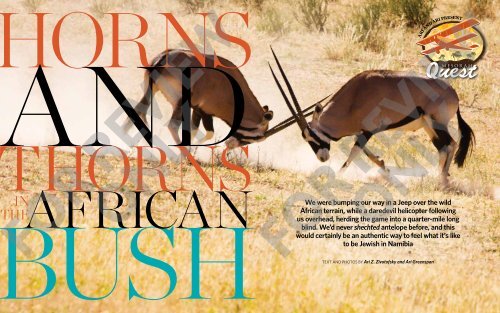

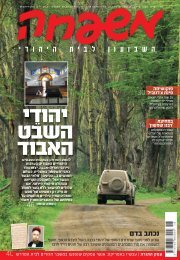
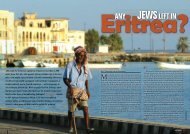
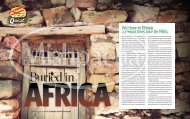

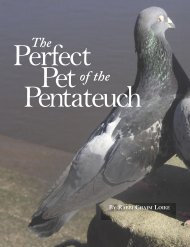
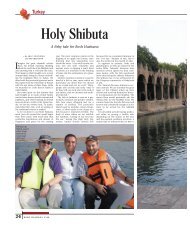
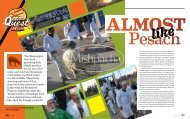

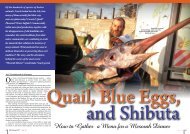
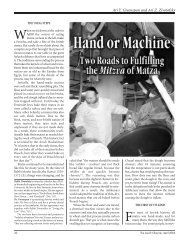
![llVtlwnl 1p1l 1biip 3 K11lnM o1it1 [1] - Halachic Adventures](https://img.yumpu.com/35271577/1/190x253/llvtlwnl-1p1l-1biip-3-k11lnm-o1it1-1-halachic-adventures.jpg?quality=85)
